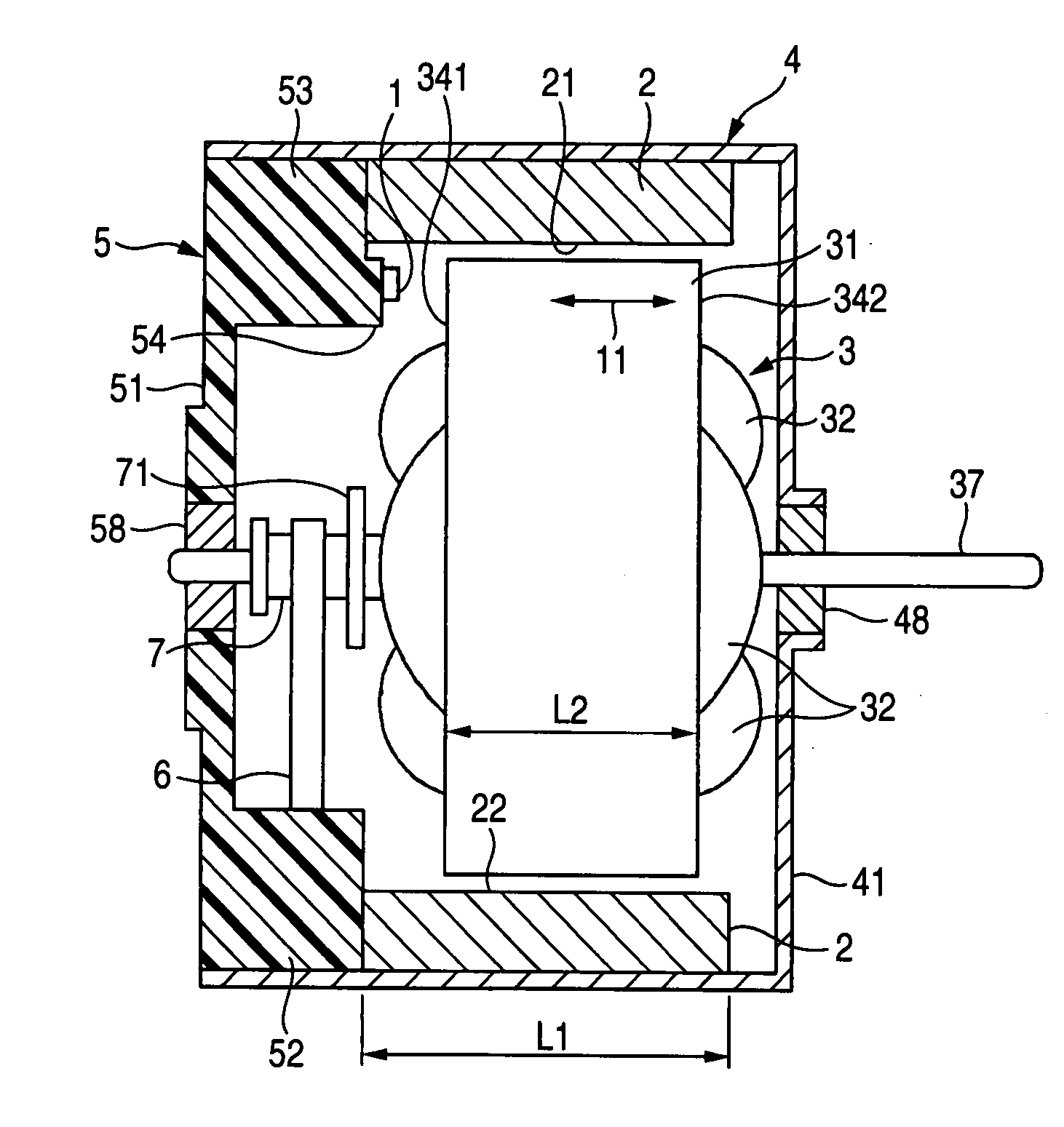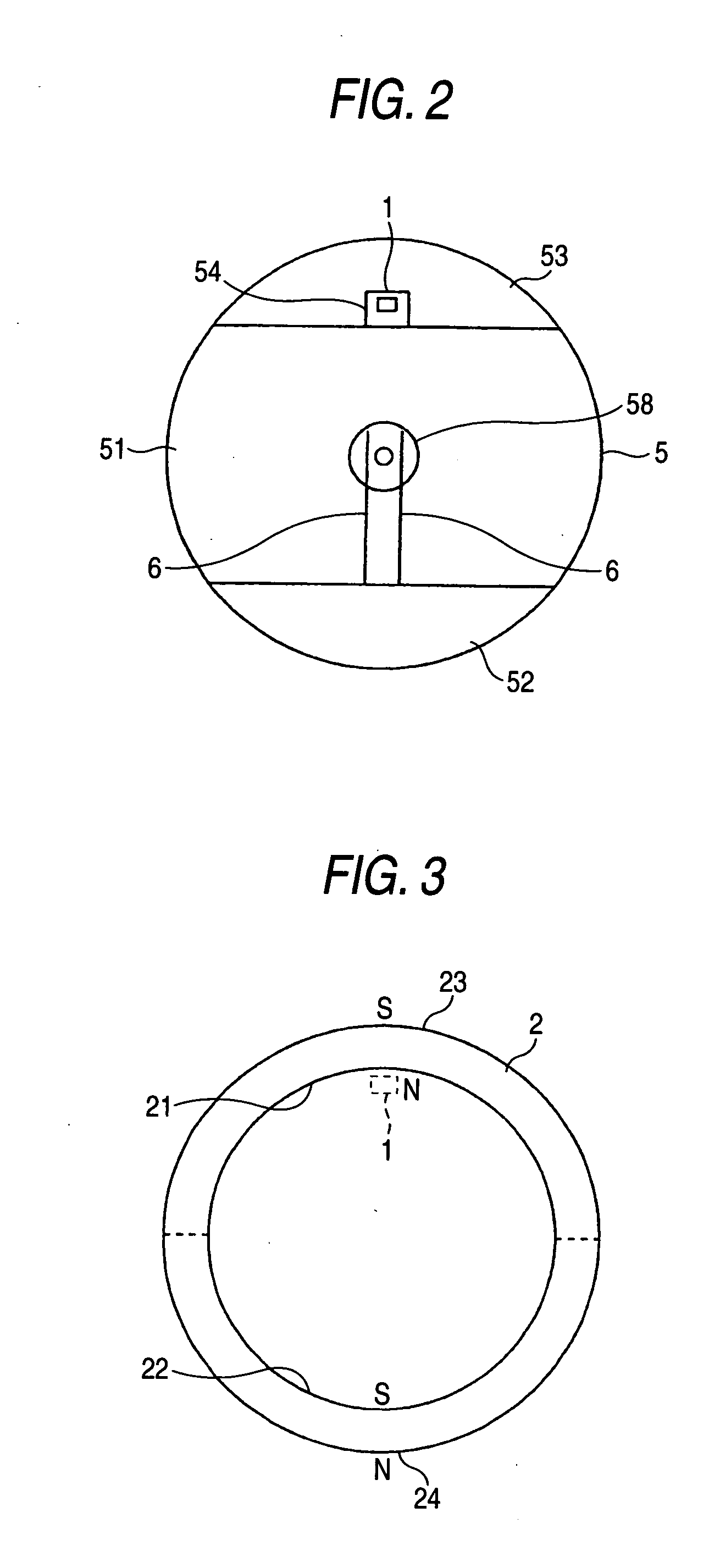Brush motor
- Summary
- Abstract
- Description
- Claims
- Application Information
AI Technical Summary
Benefits of technology
Problems solved by technology
Method used
Image
Examples
first embodiment
[0039] FIGS. 1A and 1B are structural diagrams illustrating the brush motor in accordance with the invention. FIG. 1B shows the shape as viewed from the rear side of the brush motor, and FIG. 1A shows a cross section taken along line A-A in FIG. 1B. In addition, FIG. 2 is a diagram of the shape of an end bell plate as viewed from the inner side.
[0040] In the drawings, an annular permanent magnet 2 for forming a field magnet is fitted to the inner periphery of a substantially cylindrical motor housing 4 whose one end portion is closed. A rotor 3 is rotatably supported by a bearing 58 provided in an end bell plate 5 and a bearing 48 provided in a disk-shaped front plate 41 of the motor housing 4. This rotor 3 has a rotor core 31 secured to a motor shaft 37, and the rotor core 31 has three arm portions 33. A rotor winding 32 is wound around each of the arm portions 33. Further, a commutator 7 is fitted on the motor shaft 37 on the end bell plate 5 side (reference numeral 71 denotes a n...
second embodiment
[0050] A description will be given of the operation of the second embodiment configured as described above.
[0051] It is now assumed that the rotor 3 is rotating clockwise as viewed in FIGS. 8A to 8C. In a case where the rotational position of the rotor 3 is that shown in FIG. 8A, i.e., in a case where the arcuate portion 34a which passed a position located in the vicinity of the Hall element 1a is located closer to the Hall element 1a than the arcuate portion 34b, the magnetic field formed between the inner peripheral surface 21 of the jutting-out portion of the permanent magnet 2 and the arcuate portion 34a passes through the Hall element 1a (indicated at 261). Further, when the rotor 3 has rotated from the rotational position shown in FIG. 8A through a slight angle, the magnetic field formed between the inner peripheral surface 21 of the jutting-out portion of the permanent magnet 2 and the arcuate portion 34b passes through the Hall element 1a (indicated at 262), as shown in FIG....
third embodiment
[0056] In addition, in the third embodiment, a waveform shaping circuit is used for generating accurate FG pulses with a simple circuit configuration without making the circuit configuration complex in both the forward rotation and reverse rotation of the rotor 3 on the basis of the output waveform produced due to the characteristics of the detection coil 1b. Referring to FIG. 11, a description will be given of a rotation control unit having this waveform shaping circuit.
[0057] A resistor R1 and a resistor R2 make up a voltage dividing circuit for dividing the voltage (5 V) of a plus power supply P in half. The voltage-divided output of 2.5 V is led as a reference voltage to a plus input of an OP amplifier 771 and a minus input of an OP amplifier 772. In addition, one terminal of the detection coil 1b is led to a minus input of the OP amplifier 771 through a resistor R3. The other terminal of the detection coil 1b is connected to the plus input of the OP amplifier 771. Further, a re...
PUM
 Login to View More
Login to View More Abstract
Description
Claims
Application Information
 Login to View More
Login to View More - R&D
- Intellectual Property
- Life Sciences
- Materials
- Tech Scout
- Unparalleled Data Quality
- Higher Quality Content
- 60% Fewer Hallucinations
Browse by: Latest US Patents, China's latest patents, Technical Efficacy Thesaurus, Application Domain, Technology Topic, Popular Technical Reports.
© 2025 PatSnap. All rights reserved.Legal|Privacy policy|Modern Slavery Act Transparency Statement|Sitemap|About US| Contact US: help@patsnap.com



